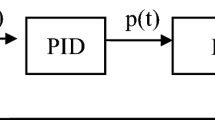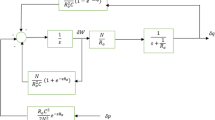Abstract
AQM router aims primarily to control the network congestion through marking/dropping packets which are used as congestion feedback in traffic sources to balance their flow rate. However, stabilizing queuing delay and maximizing link utilization have been considered as the main control objectives, especially in media dominated networks. Usually, most of the AQM algorithms are designed for a nominal operating point. However, time-varying nature of network parameters frequently violates their robustness bounds. In this paper, a self-tuning compensated PID controller is proposed to address the time-varying nature of network conditions caused by parameter variations and unresponsive connections. The proposed scheme consists of network parameter estimation and a self-tuning AQM. Traffic load, network delay, and bottleneck link capacity are the time-varying network parameters whose variation effects should be compensated by the controller gains adaptation. As the controller gains are simply and directly obtained from the dynamic model, the obtained self-tuning controller can reasonably adapt itself to different operating conditions, while preserving the simplicity of the PI controllers. Packet-level simulations using ns2 show the outperformance of the developed controller for both latency regulation and resource utilization.



















Similar content being viewed by others
Explore related subjects
Discover the latest articles, news and stories from top researchers in related subjects.References
Abbas, G., Manzoor, S., & Hussain, M. (2018). A stateless fairness-driven active queue management scheme for efficient and fair bandwidth allocation in congested internet routers. Telecommunication Systems, 67(1), 3–20.
Aweya, J., Ouellette, M., & Montuno, D. (2001). An optimization-oriented view of random early detection. Computer Communications, 24(12), 1170–1187.
Bhatnagar, S., Patel, S., & Karmeshu, (2018). A stochastic approximation approach to active queue management. Telecommunication Systems, 68(1), 89–104.
Braden, B., Clark, D., Crowcroft, J., Davie, B., Deering, S., Estrin, D., Floyd, S., Jacobson, V., Minshall, G., Partridge, C., Peterson, L., Ramakrishnan, K., Shenker, S., Wroclawski, J., & Zhang, L. (1998). Recommendations on queue management and congestion avoidance in the internet. In RFC 2309.
Cao, J., Cleveland, W., Gao, Y., Jeffay, K., Smith, F., & Weigle, M. (2004). Stochastic models for generating synthetic HTTP source traffic. IEEE INFOCOM, 3, 1546–1557.
Chen, Q., & Yang, O. (2004). On designing self-tuning controllers for AQM routers supporting TCP flows based on pole placement. IEEE Journal on Selected Areas in Communications, 22(10), 1965–1974.
Christiansen, M., Jeffay, K., Ott, D., & Smith, F. (2001). Tuning RED for web traffic. IEEE/ACM Transactions on Networking, 9(3), 249–264.
Chrost, L., & Chydzinski, A. (2016). On the deterministic approach to active queue management. Telecommunication Systems, 63(1), 27–44.
De Schepper, K., Bondarenko, O., Tsang, I. J., & Briscoe, B. (2016). PI2: A Linearized AQM for both classic and scalable TCP. In Proceedings of the 12th international conference on emerging networking experiments and technologies (pp. 105–119.) ACM.
Dukkipati, N. (2008). Rate control protocol (RCP): Congestion control to make flows complete quickly. PhD thesis, Stanford, CA, USA.
Esaki, H. (2010). A consideration on R&D direction for future internet architecture. International Journal of Communication Systems, 23(6–7), 694–707.
Feng, W. C., Kandlur, D., Saha, D., & Shin, K. (1999). A self-configuring RED gateway. In Proceedings of eighteenth annual joint conference of the IEEE computer and communications societies (INFOCOM99) (Vol. 3, pp. 1320–1328).
Floyd, S., & Jacobson, V. (1993). Random early detection gateways for congestion avoidance. IEEE/ACM Transactions on Networking, 1(4), 397–413.
Floyd, S., Gummadi, R., Shenker, S., et al. (2001). Adaptive RED: An algorithm for increasing the robustness of REDs active queue management. Preprint, available at http://www.icir.org/floyd/papers.html.
Guan, X., Yang, B., Zhao, B., Feng, G., & Chen, C. (2007). Adaptive fuzzy sliding mode active queue management algorithms. Telecommunication Systems, 35(1), 21–42.
Gustafsson, F., & Gustafsson, F. (2000). Adaptive filtering and change detection (Vol. 1). Londres: Wiley.
He, L., & Zhou, H. (2017). Robust Lyapunov–Krasovskii based design for explicit control protocol against heterogeneous delays. Telecommunication Systems, 66(3), 377–392.
He, X., Papadopoulos, C., Heidemann, J., Mitra, U., & Riaz, U. (2009). Remote detection of bottleneck links using spectral and statistical methods. Computer Networks, 53(3), 279–298.
Hollot, C., Misra, V., Towsley, D., & Gong, W. (2002). Analysis and design of controllers for AQM routers supporting TCP flows. IEEE Transactions on Automatic Control, 47(6), 945–959.
Hong, Y., & Yang, O. W. W. (2006). Adaptive AQM controllers for IP routers with a heuristic monitor on TCP flows. International Journal of Communication Systems, 19(1), 17–38.
Isidori, A. (1997). Nonlinear Control Systems. New York: Springer.
Jacobsson, K., Hjalmarsson, H., Möller, N., & Johansson, K. H. (2004). Estimation of RTT and bandwidth for congestion control applications in communication networks. In IEEE CDC. Paradise Island, Bahamas: IEEE.
Jarvinen, I., & Kojo, M. (2014). Evaluating CoDel, PIE, and HRED AQM techniques with load transients. In IEEE 39th conference on local computer networks (LCN) (pp. 159–167).
Kahe, G., & Jahangir, A. (2013). On the Gaussian characteristics of aggregated short-lived flows on high-bandwidth links. In 27th International conference on advanced information networking and applications workshops (WAINA) (pp. 860–865).
Kahe, G., Jahangir, A. H., & Ebrahimi, B. (2014). AQM controller design for TCP networks based on a new control strategy. Telecommunication Systems, 57(4), 295–311.
Karmeshu, P. S., & Bhatnagar, S. (2017). Adaptive mean queue size and its rate of change: Queue management with random dropping. Telecommunication Systems, 65(2), 281–295.
Katabi, D., Handley, M., & Rohrs, C. (2002). Congestion control for high bandwidth-delay product networks. In Proceedings of the 2002 conference on applications, technologies, architectures, and protocols for computer communications (SIGCOMM ’02, pp. 89–102). New York, NY: ACM.
Khademi, N., Ros, D., & Welzl, M. (2014). The new AQM kids on the block: An experimental evaluation of CoDel and PIE. In IEEE conference on computer communications workshops (INFOCOM WKSHPS) (pp. 85–90).
Kim, W. J., & Lee, B. G. (1998). FRED: Fair random early detection algorithm for TCP over ATM networks. Electronics Letters, 34(2), 152–154.
Ko, E., An, D., Yeom, I., & Yoon, H. (2012). Congestion control for sudden bandwidth changes in TCP. International Journal of Communication Systems, 25(12), 1550–1567.
Li, F., Sun, J., Zukerman, M., Liu, Z., Xu, Q., Chan, S., et al. (2014). A comparative simulation study of TCP/AQM systems for evaluating the potential of neuron-based AQM schemes. Journal of Network and Computer Applications, 41, 274–299.
Manfredi, S., di Bernardo, M., & Garofalo, F. (2009). Design, validation and experimental testing of a robust AQM control. Control Engineering Practice, 17(3), 394–407.
Marami, B., & Haeri, M. (2010). Implementation of MPC as an AQM controller. Computer Communications, 33(2), 227–239.
Melchor-Aguilar, D., & Niculescu, S. I. (2009). Computing non-fragile PI controllers for delay models of TCP/AQM networks. International Journal of Control, 82(12), 2249–2259.
Misra, V., Gong, W. B., & Towsley, D. (2000). Fluid-based analysis of a network of AQM routers supporting TCP flows with an application to RED. ACM SIGCOMM Computer Communication Review, 30, 151–160.
Na, Z., Guo, Q., Gao, Z., Zhen, J., & Wang, C. (2012). A novel adaptive traffic prediction AQM algorithm. Telecommunication Systems, 49(1), 149–160.
Nichols, K., & Jacobson, V. (2012). Controlling queue delay. Queue, 10(5), 20:20–20:34.
Ott, T. J., Lakshman, T. V., & Wong, L. H. (1999). SRED: Stabilized RED. In Eighteenth annual joint conference of the IEEE computer and communications societies (INFOCOM 1999) (Vol. 3, pp. 1346–1355).
Pan, R., Prabhakar, B., & Psounis, K. (2000). CHOKe—A stateless active queue management scheme for approximating fair bandwidth allocation. In Proceedings IEEE INFOCOM 2000 (Vol. 2, pp. 942–951).
Pan, R., Natarajan, P., Piglione, C., Prabhu, M., Subramanian, V., Baker, F., & VerSteeg, B. (2013). PIE: A lightweight control scheme to address the bufferbloat problem. In IEEE 14th international conference on high performance switching and routing (HPSR) (pp. 148–155).
Pan, R., Natarajan, P., Baker, F., & White, G. (2017). Proportional integral controller enhanced (PIE): A lightweight control scheme to address the bufferbloat problem. In Internet requests for comments (No RFC 8033).
Quet, P. F., & Ozbay, H. (2004). On the design of AQM supporting TCP flows using robust control theory. IEEE Transactions on Automatic Control, 49(6), 1031–1036.
Reddy, C. P., & Venkata Krishna, P. (2015). Ant-inspired level-based congestion control for wireless mesh networks. International Journal of Communication Systems, 28(8), 1493–1507.
Ryu, S. (2004). PAQM: an adaptive and proactive queue management for end-to-end TCP congestion control. International Journal of Communication Systems, 17(8), 811–832.
Schwardmann, J., Wagner, D., & Kühlewind, M. (2014). Evaluation of ARED, CoDel and PIE. In Proceedings of the 20th EUNICE/IFIP WG 6.2, 6.6 workshop on advances in communication networking (pp. 185–191). Cham, Rennes, France: Springer International Publishing. https://doi.org/10.1007/978-3-319-13488-8_17.
Sun, J., & Zukerman, M. (2007). An adaptive neuron AQM for a stable Internet. International conference on research in networking (pp. 844–854). Atlanta: Springer.
Sun, J., Chan, S., Ko, K. T., Chen, G., & Zukerman, M. (2006). Neuron PID: A robust AQM scheme. In Proceedings of ATNAC, Melbourne, Australia (pp. 259–262).
Sun, J., Chan, S., & Zukerman, M. (2012). IAPI: An intelligent adaptive PI active queue management scheme. Computer Communications, 35(18), 2281–2293.
Üna, H., Melchor-Aguilar, D., Üstebay, D., Niculescu, S. I., & Özbay, H. (2013). Comparison of PI controllers designed for the delay model of TCP/AQM networks. Computer Communications, 36(10), 1225–1234.
Wang, P., Chen, H., Yang, X., & Ma, Y. (2012). Design and analysis of a model predictive controller for active queue management. ISA Transactions, 51(1), 120–131.
Wang, P., Zhu, D., & Lu, X. (2017). Active queue management algorithm based on data-driven predictive control. Telecommunication Systems, 64(1), 103–111.
Wu, W., Ren, Y., & Shan, X. (2001). A self-configuring PI controller for active queue management. In Asia-Pacific conference on communications (APCC).
Yan, Q., & Lei, Q. (2011). A new active queue management algorithm based on self-adaptive fuzzy neural-network PID controller. In International conference on internet technology and applications (iTAP), Wuhan, China (pp. 1–4).
Zhang, C., Khanna, M., & Tsaoussidis, V. (2004). Experimental assessment of RED in wired/wireless networks. International Journal of Communication Systems, 17(4), 287–302.
Zhang, H., Towsley, D., Hollot, C. V., & Misra, V. (2003). A self-tuning structure for adaptation in TCP/AQM networks. In Proceedings of the ACM international conference on measurement and modeling of computer systems (SIGMETRICS) (SIGMETRICS ’03, pp. 302–303). New York, NY: ACM
Zheng, B., & Atiquzzaman, M. (2008). A framework to determine the optimal weight parameter of RED in next-generation internet routers. International Journal of Communication Systems, 21(9), 987–1008.
Zheng, F., & Nelson, J. (2009). An \(h_{\infty }\) approach to the controller design of AQM routers supporting TCP flows. Automatica, 45(3), 757–763.
Zhou, C., Di, D., Chen, Q., & Guo, J. (2009). An adaptive AQM algorithm based on neuron reinforcement learning. In IEEE international conference on control and automation, Christchurch, New Zealand (pp. 1342–1346).
Author information
Authors and Affiliations
Corresponding author
Rights and permissions
About this article
Cite this article
Kahe, G., Jahangir, A.H. A self-tuning controller for queuing delay regulation in TCP/AQM networks. Telecommun Syst 71, 215–229 (2019). https://doi.org/10.1007/s11235-018-0526-1
Published:
Issue Date:
DOI: https://doi.org/10.1007/s11235-018-0526-1




